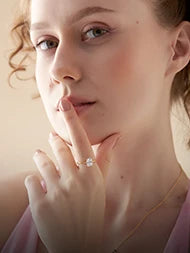How To Know The Quality of Your Diamond: The 4C's
If you ever wonder how the quality of your diamonds is determined and if you are getting them at the right price, then you are at the right place. There was once a time when a goldsmith could define the quality of diamond through only descriptive words.
Did you know the transparency was described with phrases such as 'shiny as water', 'first water', and 'milky.' You had to take the word of the jeweller when they scratch-tested your diamond against other stones.
In this guide, we will cover all the 4Cs of diamonds and how to perform some basic tests at home, which are not as precise as professional evaluations but can still give you valuable insights into your diamond's quality. Keep reading to discover how you can assess your gem with simple at-home methods!

The 4C's of Diamond Quality
Understanding these four characteristics will help you make an informed decision
Cut
The cut of a diamond refers to how wonderfully is the diamond able to reflect light. The cut looks at the proportions and arrangement of the diamond's facets, which influence its brilliance, sparkle, and fire. The grading scale ranges from Excellent to Poor.
How to Test The Cut of Your Diamond at Home?
- Hold the diamond under a bright light and observe its sparkle.
- A well-cut diamond will reflect light brilliantly.
- A poorly-cut diamond will appear dull or have dark spots.

Color

Interestingly, the color in this grading system is for the lack of color. The more the absence of color, the better the quality. The scale ranges from D to Z with D being the most colorless. Any color beyond Z are termed as fancy colors.
How to Test The Color of Your Diamond at Home?
- Place the diamond on a white piece of paper and compare it to another diamond or a cubic zirconia.
- High-quality diamonds appear colorless.
- Lower-grade diamonds may have a yellow or brownish tint.
Clarity
A diamond inclusion is an imperfection or flaw inside. These are caused during the making of the diamond due to extreme heat or pressure. The Clarity in the 4C's check these flaws and the lesser the inclusions, the more the clarity and hence, better the quality of your diamond.
How to Test the Clarity of your Diamond at Home?
- Use a 10x magnifying glass (loupe) to look for tiny spots, cracks, or cloudiness.
- Flawless diamonds have no visible inclusions.
- Lower clarity diamonds have visible imperfections (black spots, cloudy areas).

Carat

The carat of a diamond is often mistaken with the size of the diamond. The carat measures the weight. Each carat is subdivided into 100 points. One point is one hundredth of a carat. One carat weighs just as much as a standard paperclip. Diamonds are weighed in carats to give you a more precise measurement as the size may vary based on cuts and shape.
How to Test the Carat of Your diamond at Home?
- Place the diamond on a digital scale (to the hundredth of a gram).
- 1 carat = 0.2 grams.
Natural vs Lab Grown Diamonds
Understanding your options for making the best choice
Natural Diamonds
- Billions of years old
- Higher investment value
- Traditional luxury appeal
- Unique natural characteristics
Lab Grown Diamonds
- Superior clarity guaranteed
- Precisely cut brilliance
- Ethically produced gems
- More carat for cost


